Poison Ivy and Jewelweed
Poison ivy, the nemesis of many outdoor enthusiasts, has a notorious reputation for causing itchy, blistering rashes. Yet, nature provides a remarkable solution in the form of Jewelweed, a natural remedy just as potent as the problem. This article delves into the symbiotic relationship between these two plants and how Jewelweed offers relief from poison ivy’s unpleasant effects.
Key Takeaways
- Poison ivy causes allergic reactions; Jewelweed offers a natural remedy.
- Recognizing both plants is crucial for effective treatment.
- Jewelweed’s historical and current use demonstrates its efficacy.
Table of Contents
- Poison Ivy
- Identifying Poison Ivy
- Jewelweed: Nature’s Remedy
- Harvesting and Preparing Jewelweed
- Growing or Wild Harvesting Jewelweed
- Maximizing Jewelweed’s Benefits
- Top 10 Frequently Asked Questions
- Conclusion
Poison Ivy and Its Effects
Poison ivy, known scientifically as Toxicodendron radicans, is a widespread plant in North America, infamous for its skin-irritating properties. The culprit behind the irritation is urushiol, an oily compound found in the plant. When this oil comes into contact with the skin, it often triggers an allergic reaction, resulting in a rash characterized by redness, itching, and blisters.
For many, a mere brush against poison ivy leaves can lead to days, sometimes weeks, of discomfort. The plant is not always easy to identify, as it adapts to various environments, sometimes as a vine, at other times as a shrub. Its leaves typically grow in groups of three, a key feature in its identification. However, variations in leaf shape and color can occur, adding to the challenge of spotting it in the wild.
Given the discomfort and prevalence of poison ivy, finding effective remedies is crucial for those who love the outdoors. This is where Jewelweed, a humble plant often found growing in the same habitats as poison ivy, comes into play.
Identifying Poison Ivy
Key Characteristics
Poison ivy is known for its distinctive features:
- Leaves of Three: Poison ivy typically has three leaflets per leaf group.
- Variable Leaf Shape: The leaves can be rounded or pointed, and sometimes resemble a mitten or heart shape.
- Color Changes: Leaves are usually green in the summer, but they can turn red or yellow in the fall.
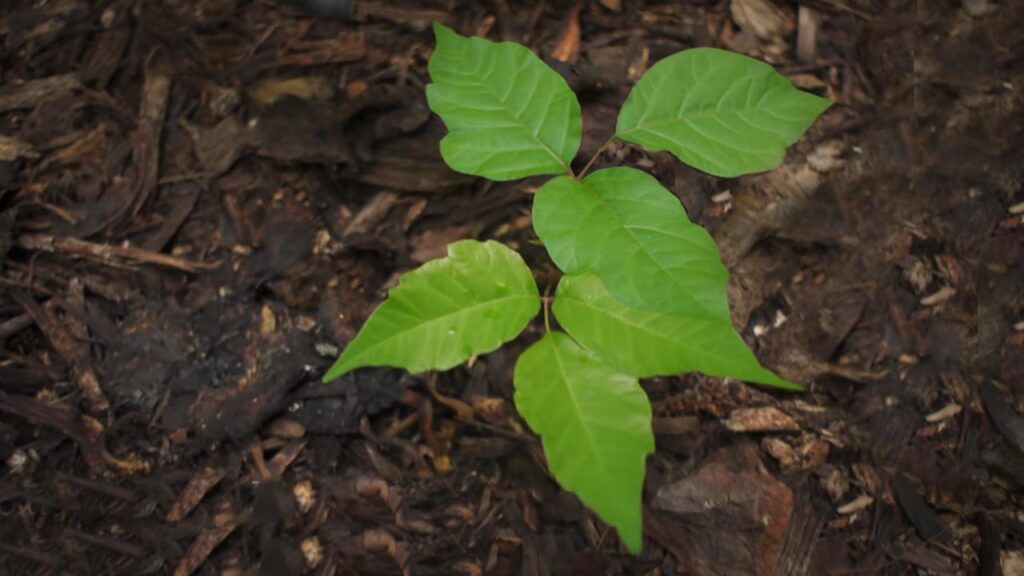
Growth Forms
Poison ivy can appear in various forms:
- Vines or Shrubs: It may grow as a groundcover, a climbing vine, or a freestanding shrub.
- Hairy Vines: When climbing, the vines often have hair-like growths.
Habitat
- Poison ivy thrives in a variety of environments, from woodlands to riverbanks and roadside areas.
Seasonal Changes
- In spring, leaves may be reddish, turning green in summer, and then yellow, orange, or red in the fall.
- White berries may appear in late summer to fall.
Caution While Identifying
- Always wear protective clothing when exploring areas where poison ivy might grow.
- Remember the adage, “Leaves of three, let it be” to avoid potential contact.
Jewelweed: Nature’s Remedy
Jewelweed (Impatiens capensis), also known as Touch-Me-Not, is a wild plant native to North America and celebrated for its healing properties, especially against poison ivy rashes. The plant, belonging to the Impatiens family, thrives in moist, shady areas, often co-existing with poison ivy.
Historically, Jewelweed has been used by Native Americans, herbalists, and pioneers as a natural remedy for various skin irritations, including those caused by poison ivy, oak, and insect bites. The plant’s succulent stems contain a gooey liquid, similar to aloe, known for its skin-soothing properties. When applied to the skin, this liquid can help alleviate the itching and inflammation associated with poison ivy rashes.
In addition to its anti-itching properties, Jewelweed is believed to help dry out the blisters caused by poison ivy. Its use is not just limited to poison ivy reactions; it also shows promise as an antifungal agent, effective against conditions like athlete’s foot and ringworm. Some Native American tribes have traditionally used Jewelweed in teas as a diuretic and digestive aid.
As we transition through the seasons, the availability and potency of Jewelweed’s juice vary. In spring and early summer, the juice is abundant in the leaves and stems, making it the ideal time for fresh application or preparation of remedies. However, as summer wanes and the plant matures, the stems toughen, yet they still contain useful juice. During this later stage, creating a tincture from Jewelweed is recommended.
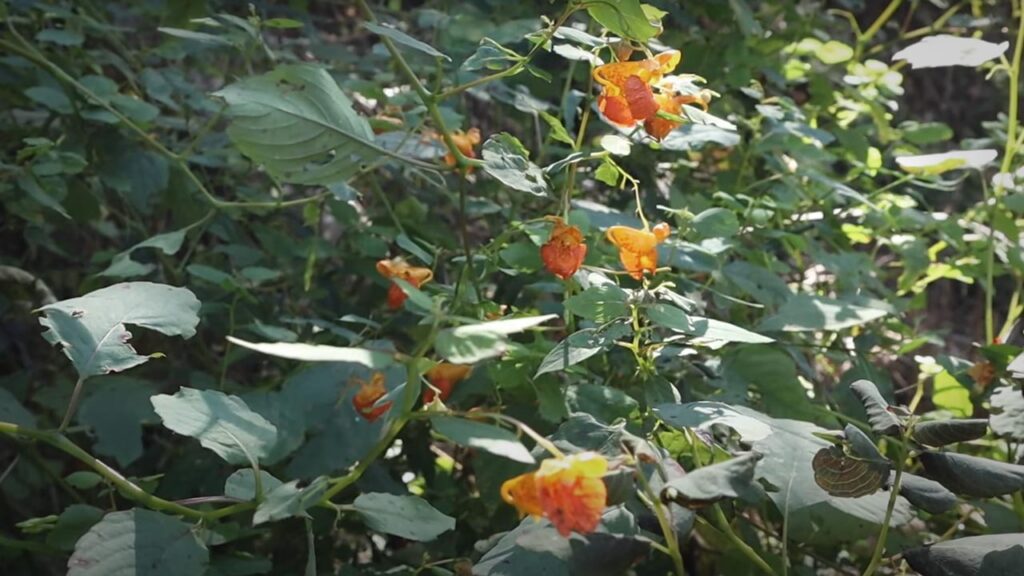
Harvesting and Preparing Jewelweed
Jewelweed Tincture
Creating a Jewelweed tincture is a straightforward process. You’ll need a quart jar, chopped stems, leaves, and flowers of Jewelweed, and alcohol (80 proof vodka is a good choice). Here’s the process:
- Fill the jar half full with Jewelweed. Add a few leaves of plantain, yarrow, chickweed, cleavers, and comfrey, all chopped.
- Cover the mixture with alcohol, ensuring it’s at least a quarter of an inch above the leaves.
- Seal the jar tightly and shake it. Leave it in sunlight, shaking daily for at least three weeks.
- After three weeks, strain the mixture. Store your tincture in a cool, dark place.
Jewelweed Poison Ivy Solution
Using the tincture, you can make a Jewelweed poison ivy solution. You’ll need a pint jar, 4 ounces of the Jewelweed tincture, distilled water, lavender and tea tree essential oils, cotton cosmetic pads, and a small jar with a tight-fitting lid.
- Place 10-12 cotton pads in the smaller jar.
- Pour the tincture into the pint jar, then add distilled water to double the volume, achieving a 20% alcohol solution.
- Add 5 drops each of lavender and tea tree essential oils. Shake well.
- Immediately pour the solution over the cotton pads, ensuring they’re fully saturated.
- Store any remaining solution for up to 4 months.
To use this treatment, simply squeeze excess liquid from a cotton pad and apply to the affected area. It’s effective for poison ivy, oak, or sumac rashes, as well as bug bites and minor scratches.
Growing or Wild Harvesting Jewelweed
Ideal Locations for Wild Harvesting
Jewelweed often grows in damp, shaded areas like marshes, along creeks, or in moist woodlands. When wild harvesting, it’s essential to look for areas with consistent moisture and partial to full shade.
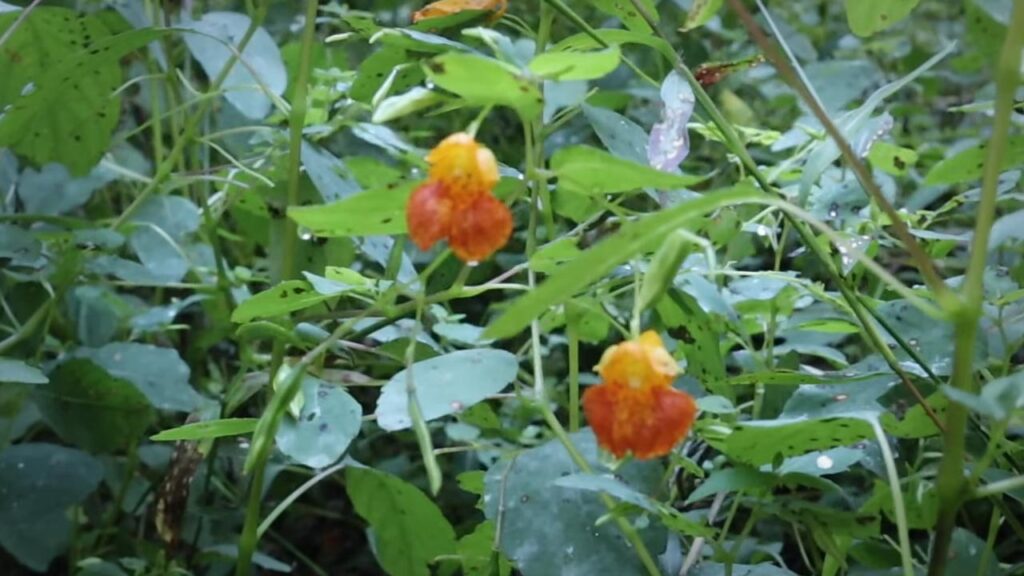
Sustainable Harvesting Practices
When harvesting Jewelweed in the wild, it’s crucial to practice sustainability:
- Only harvest the top third of the plant, allowing the lower two-thirds to continue growing.
- Avoid overharvesting in a single area to ensure the plant population remains robust.
Growing Jewelweed in Your Garden
For those interested in cultivating Jewelweed:
- Jewelweed prefers moist, rich soil and partial shade.
- Sow seeds directly in the soil in early spring. The plant is an annual but reseeds itself readily.
- Regular watering is essential, especially during dry periods.
- Jewelweed can grow quite tall (up to 5 feet), so plan for adequate space.
Caring for Jewelweed
- Jewelweed is relatively low-maintenance but watch for signs of disease or pests.
- As an annual, it will die off in the frost but expect new growth from seeds the following spring.
Maximizing Jewelweed’s Benefits: Additional Applications and Tips
Broader Applications of Jewelweed
Beyond treating poison ivy, Jewelweed has a variety of applications due to its anti-inflammatory and soothing properties. It’s beneficial for:
- Treating other skin irritations like insect bites and minor cuts.
- Easing fungal infections like athlete’s foot and ringworm.
- Utilizing in homemade skin care products for its soothing effects.
Effectiveness of Jewelweed: What the Studies Say
While many swear by the efficacy of Jewelweed, scientific studies offer mixed results. An older study from 1958 indicated positive outcomes, but newer research sometimes questions its effectiveness. Despite this, anecdotal evidence strongly supports Jewelweed’s role in providing relief from poison ivy and other skin irritations.
Practical Tips for Using Jewelweed
To get the most out of Jewelweed:
- Apply the juice from the stems and leaves immediately after exposure to poison ivy.
- For a DIY remedy, boil chopped Jewelweed in water to create a concentrated liquid, which can be applied directly to the skin or frozen for future use.
- Remember, while Jewelweed is helpful, it’s not a substitute for medical advice, especially in severe cases of allergic reactions.
Top 10 Frequently Asked Questions
Conclusion
As we conclude our exploration of “Poison Ivy and Nature’s Remedy: Jewelweed,” it’s clear that nature often provides its own solutions to the challenges it presents. Jewelweed, with its remarkable skin-soothing properties, stands as a testament to the power of natural remedies. By understanding how to identify and utilize this beneficial plant, we can better equip ourselves to handle the discomforts brought by poison ivy. Whether through wild harvesting or cultivating Jewelweed in our gardens, this knowledge empowers us to embrace nature’s gifts and fosters a deeper appreciation for the intricate balance within our natural world.

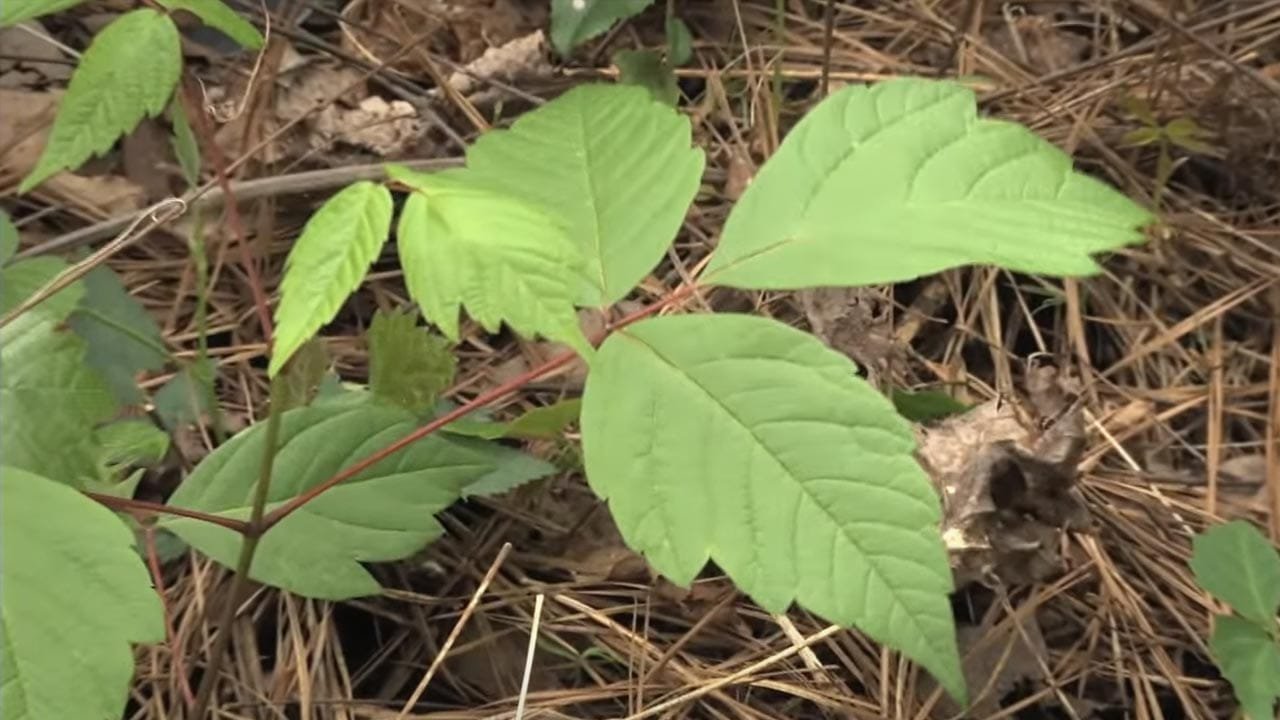




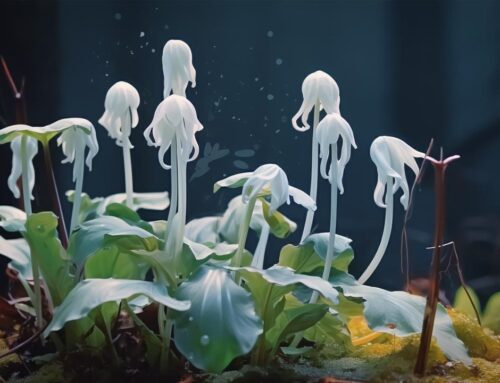
Leave A Comment